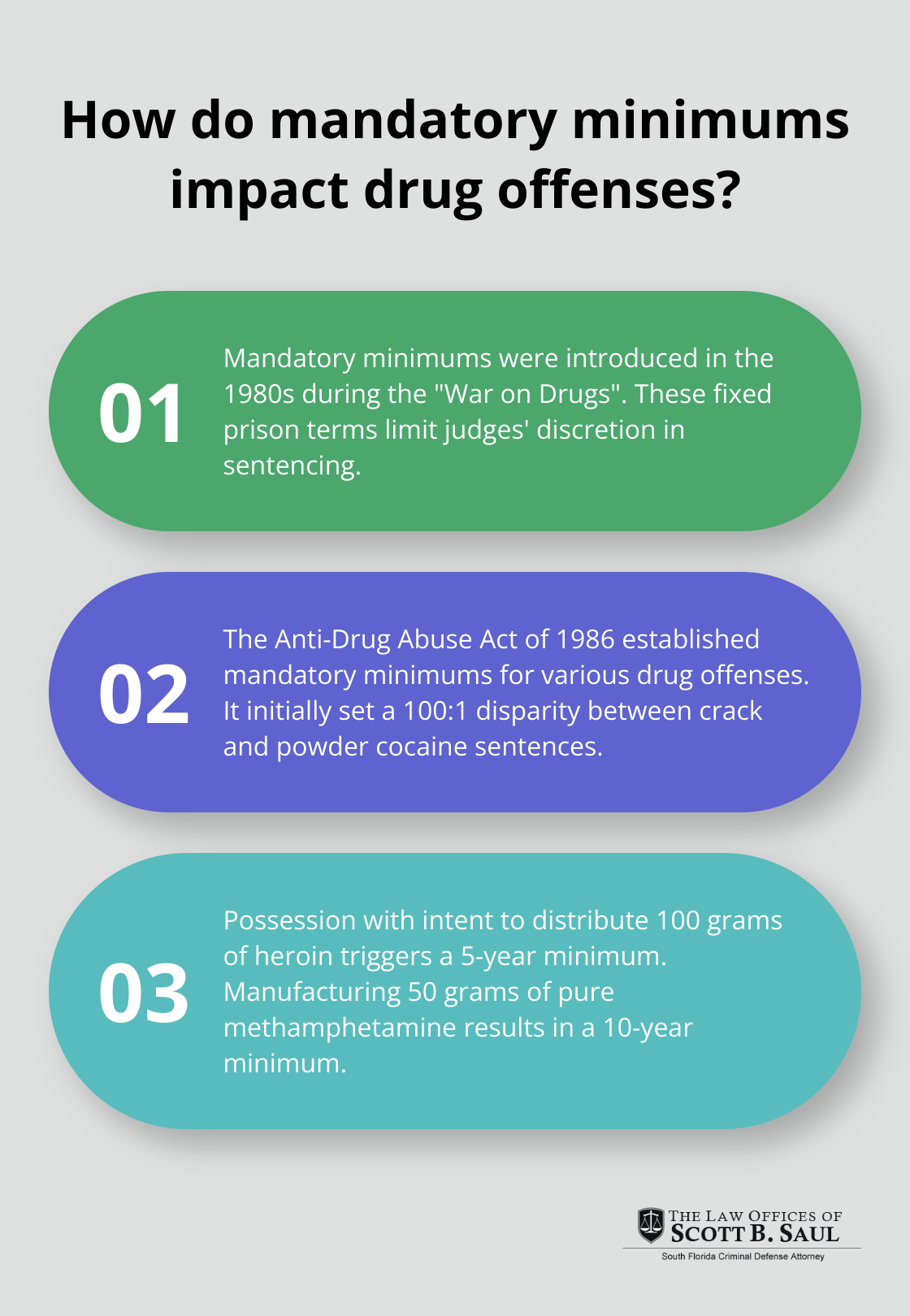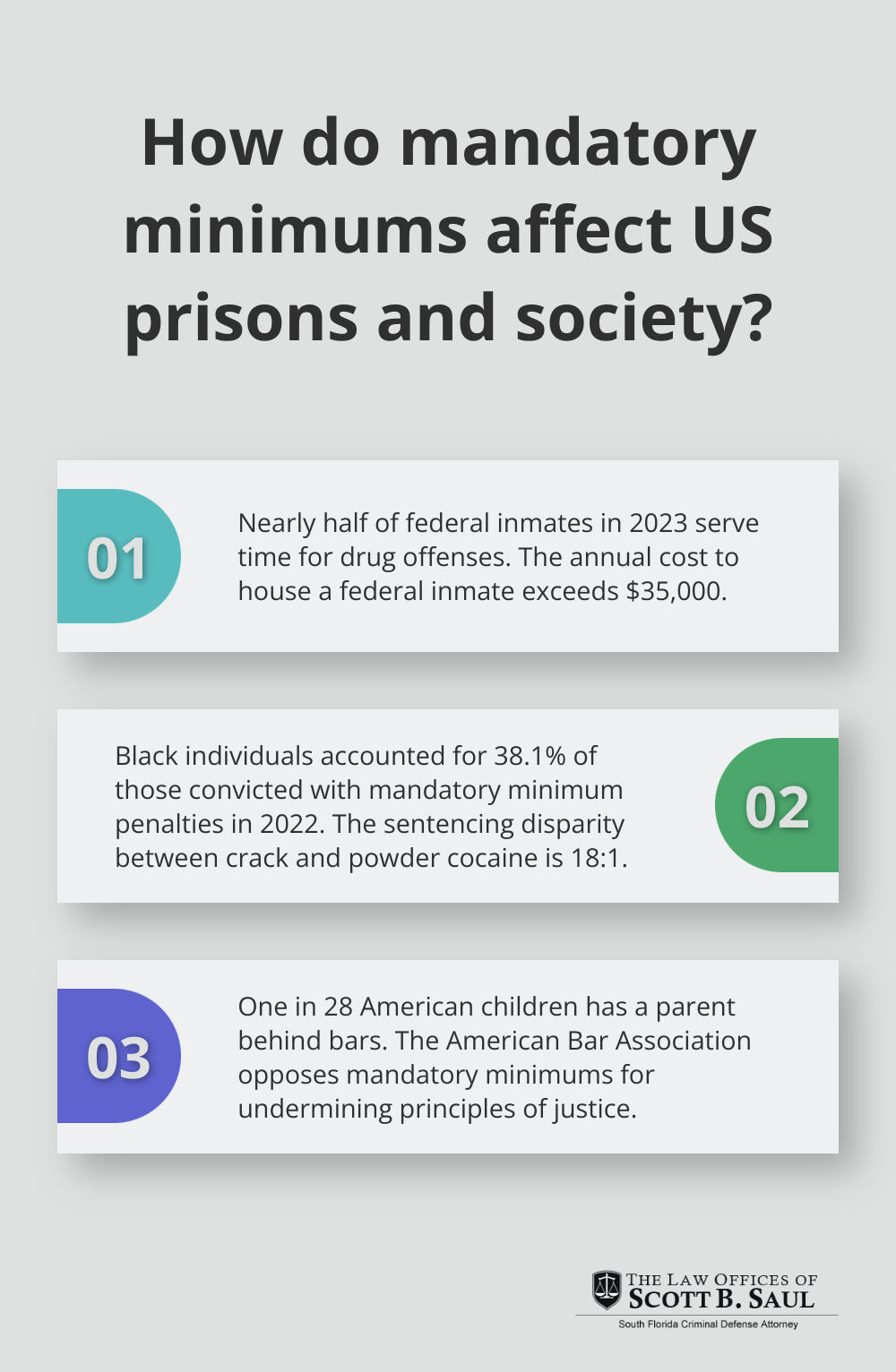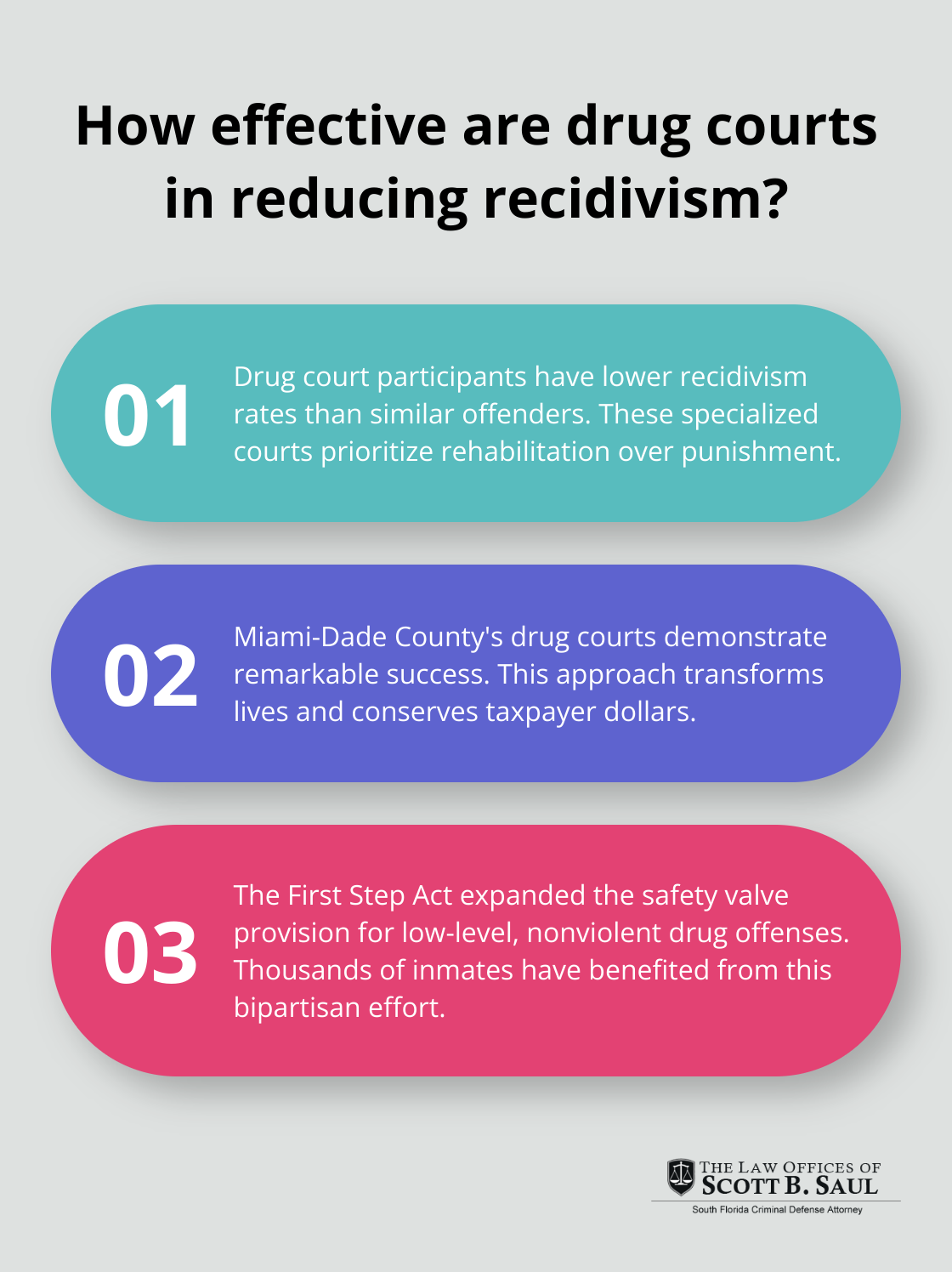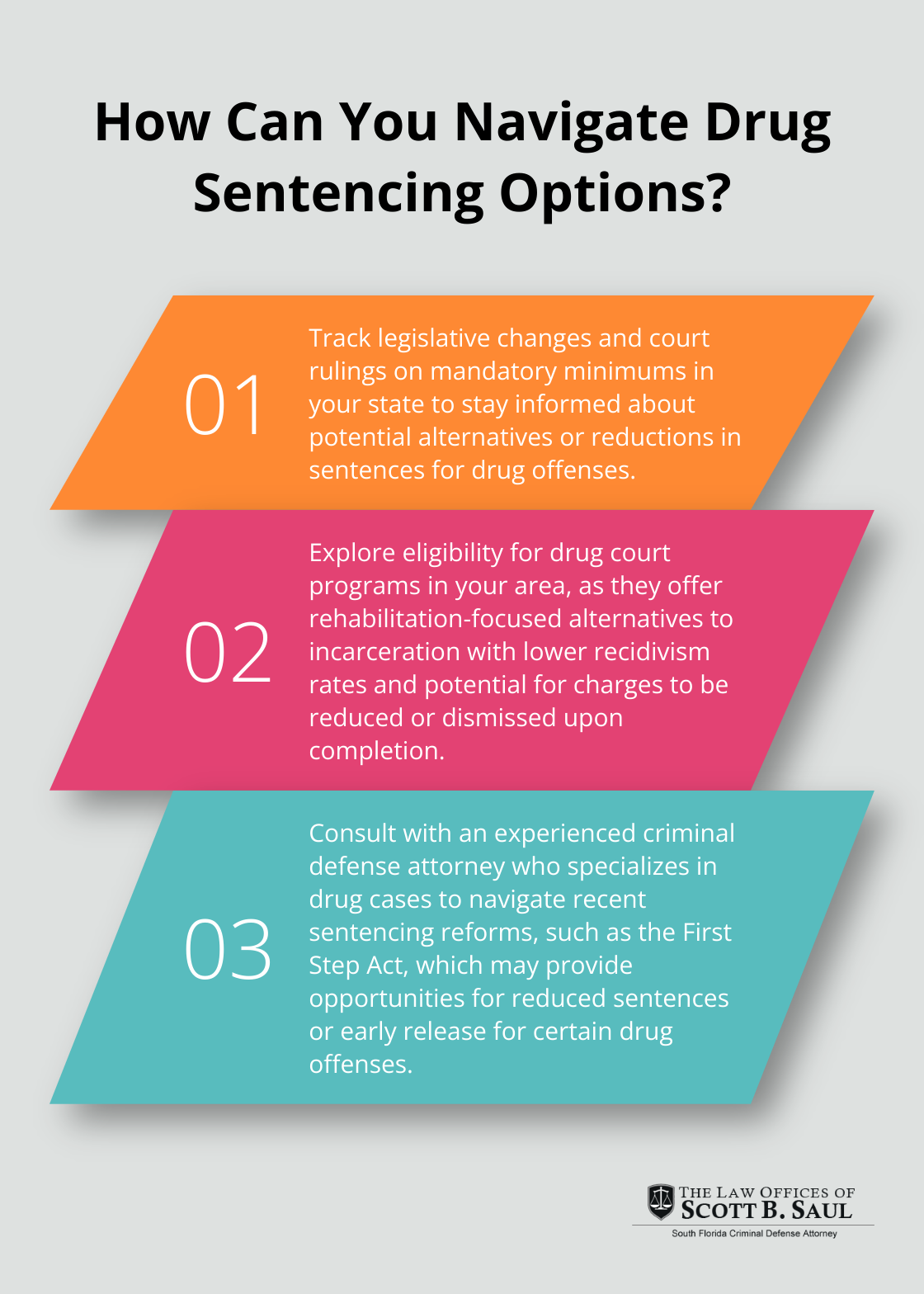Understanding Mandatory Minimums for Drug Offenses
By : saulcrim | Category : Criminal Defense | Comments Off on Understanding Mandatory Minimums for Drug Offenses
21st Dec 2024

Mandatory minimums for drug offenses have been a contentious issue in the U.S. criminal justice system for decades. These laws set fixed prison terms for certain drug crimes, regardless of individual circumstances.
At Law Offices of Scott B. Saul, we’ve seen firsthand how these sentences can dramatically impact lives. This post explores the history, effects, and ongoing debates surrounding mandatory minimums, as well as potential alternatives and recent legal changes.
What Are Mandatory Minimums for Drug Offenses?
Definition and Purpose
Mandatory minimum sentences for drug offenses are fixed prison terms set by law. These sentences limit judges’ discretion in the sentencing process. Introduced in the 1980s during the “War on Drugs,” these laws aimed to deter drug-related crimes and ensure consistent punishments across the nation.
Historical Evolution
The Anti-Drug Abuse Act of 1986 marked a significant shift in U.S. drug policy. This law provided for increased penalties for violations of the Controlled Substances Act, raised authorization ceilings for drug law enforcement, and established mandatory minimum sentences for various drug offenses, including possession, distribution, and trafficking. The severity of these sentences often depended on the type and quantity of drugs involved.

For instance, the law set a 5-year mandatory minimum for possessing 5 grams of crack cocaine, while the same sentence applied to 500 grams of powder cocaine. This 100:1 disparity (which has since been reduced) disproportionately affected minority communities and sparked intense debate about racial inequities in the justice system.
Types of Drug Offenses Subject to Mandatory Minimums
Federal law imposes mandatory minimums for a wide range of drug offenses. Here’s a breakdown of some common offenses:
- Possession with Intent to Distribute: Penalties vary based on drug type and quantity. For example, 100 grams of heroin triggers a 5-year minimum, while 1 kilogram results in a 10-year minimum.
- Drug Trafficking: Sentences increase with larger quantities and prior convictions. A second offense can double the mandatory minimum.
- Manufacturing: Production of controlled substances, including methamphetamine, carries severe penalties. For instance, producing 50 grams of pure meth results in a 10-year minimum.
Impact on Defendants and the Legal System
These laws profoundly affect defendants. Mandatory minimums often lead to plea bargains, as the risk of longer sentences at trial becomes too great. This practice has received criticism for potentially coercing innocent individuals to plead guilty.
Moreover, these laws have contributed significantly to prison overcrowding. According to the U.S. Sentencing Commission, 64.7% of the 18,818 individuals sentenced for drug offenses were convicted of an offense carrying a mandatory minimum penalty.
Understanding these laws is important for anyone facing drug charges. The complexities of mandatory minimums highlight the need for experienced legal representation to navigate potential defenses and alternatives. As we move forward, we’ll examine the broader impact of these laws on the criminal justice system and society at large.
How Mandatory Minimums Impact Our Justice System
Overcrowded Prisons and Escalating Costs
Mandatory minimum sentences for drug offenses have reshaped the American criminal justice landscape. The implementation of these policies has caused a surge in the prison population. The Federal Bureau of Prisons reports that in 2023, nearly half of all federal inmates serve time for drug offenses. This influx has pushed correctional facilities beyond capacity, which compromises rehabilitation efforts and inmate safety.

The financial burden on taxpayers is enormous. The Bureau of Prisons states that the annual cost to house a federal inmate exceeds $35,000. With longer sentences mandated for drug offenses, these costs accumulate over decades, which diverts resources from other critical areas such as education and healthcare.
Racial Disparities in Sentencing
One of the most troubling aspects of mandatory minimums is their disproportionate impact on communities of color. The U.S. Sentencing Commission’s data reveals that in 2022, Black individuals accounted for 38.1% of those convicted of offenses carrying mandatory minimum penalties (despite making up only 13.4% of the U.S. population).
This disparity is particularly evident in crack cocaine cases. The Fair Sentencing Act of 2010 reduced the sentencing disparity between crack and powder cocaine from 100:1 to 18:1, but significant inequities persist. Black Americans are still more likely to face arrest for crack cocaine offenses, despite similar usage rates across racial groups.
Unintended Consequences and Criticism
Critics argue that mandatory minimums have failed to achieve their intended goals of deterrence and consistency in sentencing. Instead, they’ve created a system that often punishes low-level offenders more harshly than high-level drug traffickers (who can provide substantial assistance to prosecutors in exchange for reduced sentences).
The American Bar Association opposes mandatory minimums, stating they undermine the fundamental principles of justice by preventing judges from considering individual circumstances. This one-size-fits-all approach can lead to unjust outcomes, particularly for first-time offenders or those with mitigating factors.
Moreover, mandatory minimums have shifted power from judges to prosecutors, who can use the threat of long sentences to pressure defendants into plea bargains. This practice raises concerns about due process and the right to a fair trial.
Broader Social Impact
The impact of these policies extends beyond the individuals sentenced. Families and communities bear the brunt of long-term incarceration, which perpetuates cycles of poverty and disadvantage. The Children’s Defense Fund estimates that one in 28 American children has a parent behind bars, with the number significantly higher for children of color.
As we continue to examine the effects of mandatory minimums, it’s clear that reform is necessary. The next section will explore alternatives and recent changes in drug sentencing laws that try to address these issues and create a more equitable system.
Alternatives to Mandatory Minimums: A Shift in Drug Offense Sentencing
Drug Courts: A Rehabilitation-Focused Approach
Drug court participants have lower rates of recidivism (drug and non-drug offending) than similar offenders who did not participate in drug courts. These specialized courts prioritize rehabilitation over punishment.

Miami-Dade County’s drug courts demonstrate remarkable success. This approach not only transforms lives but also conserves taxpayer dollars.
Sentencing Reform: Bipartisan Efforts for Change
Recent years have witnessed significant changes in federal and state drug sentencing laws. The First Step Act expanded the so-called safety valve provision, which allows courts to sentence people convicted of low-level, nonviolent drug offenses below mandatory minimum sentences. This legislation reduced mandatory minimums for certain drug offenses and expanded early release opportunities. Thousands of inmates serving disproportionately long sentences have already benefited from this bipartisan effort.
Florida has made progress with its own reform initiatives. The Florida First Step Act, modeled after its federal counterpart, aims to reduce recidivism through expanded rehabilitation programs and sentencing reforms. These changes reflect a growing consensus that treatment and education outperform lengthy incarceration in reducing drug-related crime.
Evidence-Based Rehabilitation Programs
Many jurisdictions now implement evidence-based rehabilitation programs as alternatives to incarceration. These programs often include:
- Intensive outpatient treatment
- Medication-assisted treatment for opioid addiction
- Cognitive-behavioral therapy
- Job training and placement services
The Substance Abuse and Mental Health Services Administration reports that such comprehensive approaches can reduce substance abuse among participants. Moreover, these programs cost significantly less than incarceration.
The Role of Legal Expertise in Navigating Alternatives
As the landscape of drug offense sentencing evolves, individuals facing charges must work with experienced attorneys who understand these new alternatives. Lawyers with extensive experience in South Florida’s legal system (such as those at the Law Offices of Scott B. Saul) possess the knowledge to navigate these changes and advocate for the most beneficial outcomes for their clients. Understanding how mandatory minimum sentences affect drug cases is crucial for developing effective defense strategies.
Final Thoughts
Mandatory minimums for drug offenses have shaped the American criminal justice system since the 1980s. These laws aimed to deter drug-related crimes and ensure consistent punishments, but they led to prison overcrowding and exacerbated racial disparities in sentencing. Recent years have witnessed a shift towards rehabilitation-focused approaches, with drug courts and sentencing reforms showing promising results in reducing recidivism rates.

Courts now consider more individualized factors when sentencing drug offenses, moving away from one-size-fits-all approaches. This shift acknowledges the complex nature of drug-related crimes and the diverse circumstances of those involved. The landscape of drug offense sentencing continues to evolve, making expert legal guidance invaluable for individuals facing charges.
At Law Offices of Scott B. Saul, we navigate South Florida’s legal system with extensive experience. Our understanding of mandatory minimums and alternative sentencing options allows us to develop effective defense strategies for each client’s unique situation. As reforms continue, staying informed and seeking experienced legal representation remains essential for anyone facing drug charges.
Archives
- July 2025 (3)
- June 2025 (9)
- May 2025 (9)
- April 2025 (8)
- March 2025 (9)
- February 2025 (8)
- January 2025 (9)
- December 2024 (10)
- November 2024 (5)
- July 2024 (2)
- June 2024 (2)
- May 2024 (2)
- April 2024 (2)
- March 2024 (2)
- February 2024 (2)
- January 2024 (2)
- December 2023 (2)
- November 2023 (2)
- October 2023 (2)
- September 2023 (2)
- August 2023 (1)
- July 2023 (2)
- June 2023 (2)
- May 2023 (2)
- April 2023 (2)
- March 2023 (2)
- February 2023 (2)
- January 2023 (2)
- December 2022 (2)
- November 2022 (2)
- October 2022 (2)
- September 2022 (2)
- August 2022 (2)
- July 2022 (2)
- June 2022 (2)
- May 2022 (2)
- April 2022 (2)
- March 2022 (2)
- February 2022 (2)
- January 2022 (2)
- December 2021 (2)
- November 2021 (2)
- October 2021 (2)
- September 2021 (2)
- August 2021 (2)
- July 2021 (2)
- June 2021 (2)
- May 2021 (2)
- April 2021 (2)
- September 2020 (5)
- July 2020 (4)
- June 2020 (4)
- May 2020 (4)
- April 2020 (5)
- March 2020 (4)
- February 2020 (4)
- January 2020 (4)
- December 2019 (1)
- November 2019 (4)
- October 2019 (4)
- September 2019 (4)
- August 2019 (4)
- July 2019 (5)
- June 2019 (4)
- May 2019 (4)
- April 2019 (4)
- March 2019 (4)
- February 2019 (4)
- January 2019 (4)
- December 2018 (4)
- November 2018 (5)
- October 2018 (5)
- September 2018 (4)
- August 2018 (4)
- July 2018 (7)
- June 2018 (4)
- May 2018 (4)
- April 2018 (8)
- March 2018 (4)
- February 2018 (4)
- January 2018 (4)
- November 2017 (4)
- October 2017 (4)
- September 2017 (4)
- August 2017 (7)
- July 2017 (6)
- June 2017 (4)
- May 2017 (4)
- April 2017 (4)
- March 2017 (4)
- February 2017 (7)
- January 2017 (4)
- December 2016 (7)
- November 2016 (4)
- October 2016 (4)
- September 2016 (10)
- August 2016 (4)
- July 2016 (4)
- June 2016 (4)
- May 2016 (4)
- April 2016 (4)
- March 2016 (4)
- February 2016 (7)
- January 2016 (4)
- December 2015 (5)
- November 2015 (4)
- October 2015 (7)
- September 2015 (4)
- August 2015 (4)
- July 2015 (13)
- June 2015 (9)
- May 2015 (8)
- April 2015 (6)
- March 2015 (4)
- February 2015 (4)
- January 2015 (4)
- December 2014 (4)
- November 2014 (4)
- October 2014 (4)
- September 2014 (3)
Categories
- Adjudication (1)
- Bankruptcy (1)
- Burglary Crimes (3)
- calendar call (1)
- Car Accident (1)
- Criminal Defense (334)
- Cyber Crimes (7)
- DNA (1)
- Domestic Violence (9)
- Drug Crimes (5)
- DUI (12)
- Embezzlement (1)
- Environmental Crimes (4)
- Expungement Law (2)
- Federal Sentencing Law (3)
- Firearm (3)
- Forgery (4)
- General (82)
- Healthcare (3)
- Immigration (1)
- Indentity Theft (1)
- Insurance (5)
- judicial sounding (2)
- Juvenile Crimes (4)
- Manslaughter (4)
- Money Laundering (3)
- Organized Crime (1)
- Racketeering (1)
- Reckless Driving (3)
- RICO (3)
- Sealing and Expunging (2)
- Sex Offense (1)
- Shoplifting (1)
- Suspended Driver's License (1)
- Traffic (4)
- Trending Topics (1)
- White-collar Offenses (1)

